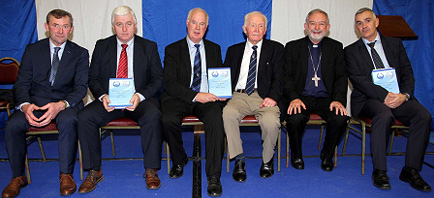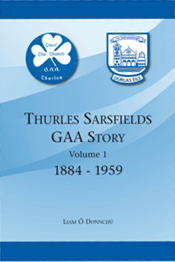|
|
‘Tis the season to be reading – Thurles Sarsfields GAA Story-Volume I – by Author Liam Ó Donnchú.
 Thurles Sarsfields GAA Story (Volume I) has now arrived in Thurles book stores and all involved with the project are delighted with its phenomenal success. Thurles Sarsfields GAA Story (Volume I) has now arrived in Thurles book stores and all involved with the project are delighted with its phenomenal success.
(Picture left: Mr Liam Ó Donnchú presenting a copy of the ‘Thurles Sarsfields GAA Story” to GAA President, Mr Aogán Ó Fearghaíl.)
The book illustrates the importance of the town of Thurles in the story of the GAA since its foundation there in 1884. The book isn’t confined merely to the games as it records many of the happenings in the town as the years have passed.
Many readers have remarked on the range and quality of the photographs, many of which have been unseen by the present generation.
Costing €25; Thurles Sarsfields GAA Story (Volume I) is available in Thurles through Bookworm, Lár na Páirce, Eason and Thurles Sarsfields Social Centre.
It can also be ordered by post (€10 extra) from: Liam Ó Donnchú, Ballymoreen, Littleton, Thurles, Co. Tipperary.
The launch of the Thurles Sarsfields GAA story took place in the Thurles Sarsfields Social Centre, here in Co. Tipperary, on Friday last, November 10th, 2017.
The publication was launched, most appropriately, by former Tipperary hurling Manager and legendary Sarsfields and Tipperary defender from the 1950’s and 1960’s, Mr Tony Wall.
 Pictured above: Speakers at the launch of the Thurles Sarsfields GAA Story were: (L to R) Mr Michael Maher (Thurles Sarsfields Chairman), Mr Michael Bourke (Tipperary GAA Chairman), Mr Liam Ó Donnchú (Author), Mr Tony Wall (Special guest who launched the publication), His Grace Archbishop Kieran O’Reilly, Mr Seamus Hanafin (Templemore / Thurles, Municipal District Chairperson). At just €25 (Hard-back / 500 pages); the Thurles Sarsfields GAA Story -Volume 1 is already the most popular and dare I say an essential Christmas gift in 2017, for all Tipp die-hard hurling fans.
Please Note: This exciting publication is now available in Thurles, through Bookworm, Lár na Páirce, Eason and Thurles Sarsfields Social Centre.
A ‘Signed Copy’ can also be ordered direct (Plus €10 extra for postage and packing) from the Author, Mr Liam Ó Donnchú, Ballymoreen, Littleton, Thurles, Co. Tipperary.
Thurles Sarsfields GAA Story-Volume 1 – by Author Liam Ó Donnchú
 Volume 1 of the Thurles Sarsfields GAA story will be launched on Friday next, November 10th, at 7.30 p.m. sharp, by former retired Tipperary, senior team centre-back, and hurling manager Mr Tony Wall, in the Thurles Sarsfields Social Centre, here in Co. Tipperary. Volume 1 of the Thurles Sarsfields GAA story will be launched on Friday next, November 10th, at 7.30 p.m. sharp, by former retired Tipperary, senior team centre-back, and hurling manager Mr Tony Wall, in the Thurles Sarsfields Social Centre, here in Co. Tipperary.
It was the same Tipperary legendary defender from the 1950’s and 1960’s; Mr Tony Wall, to whom is attributed the ‘tongue in cheek’ remark, quote, “Football is a game for those not good enough to play hurling.”
Mr Wall, a former Irish army Adjutant General (Military chief administrative officer), from Fianna Road in Thurles, joined the Tipperary team during the 1953/54 National League and became a regular member of the ‘starting fifteen’ until his retirement following the 1967 championship.
During that period, he won five All-Ireland medals, six Munster medals and six National Hurling League medals, and captained the team to the All-Ireland title in 1958. Mr Wall was himself a ten-time county club championship medallist with the legendary Thurles Sarsfields.
The Thurles Sarsfields GAA story-Volume 1; as we have previously stated does not confine itself purely to Thurles GAA affairs. Indeed, I would suggest that same can also be viewed as a social or community written commentary, with the many happenings down through the decades, affecting our rural town and surrounding parish of Thurles getting mentioned, and clearly put into date perspective; e.g. the arrival of Urban and Rural Electricity; the Thurles/Titanic connection; the official opening of Thurles Sugar Factory; the Korean War; Fair Days on Liberty Square (West Main Street) and Cathedral Street (East Main Street); The great Count John Mc Cormack’s Concert at Delahunty’s Cinema etc., etc., etc.
Please Note: All are most welcome to attend this official book launch, however if for one reason or another you cannot attend this event, remember this exciting publication will be available in Thurles, through Bookworm, Lár na Páirce, Eason and Thurles Sarsfields Social Centre. A ‘Signed Copy’ can also be ordered direct (Plus €10 extra for postage and packing) from the Author, Mr Liam Ó Donnchú, Ballymoreen, Littleton, Thurles, Co. Tipperary.
Can you remember back to 1964, when locals here in Thurles gathered to celebrate the arrival of Tipperary’s All-Ireland Hurling Captain, Michael Murphy, accompanied of course by the Liam McCarthy Cup (Tipperary’s 20th win and the then 78th staging of Ireland’s premier hurling knock-out competition); arriving to Tom O’Toole’s public house on Friar Street in the town?
No, well you can refresh your memory shortly, when “Thurles Sarsfields GAA Story – Volume 1” hits the book shelves.
 Left To Right: – Eamon Shanahan, Niall McNamara, Tom Behan, Michael Murphy, Joe Dwyer, Ned O’Shea, James Moloughney. As we have previously stated, this ‘must-own’, long-awaited and overdue hard-back publication, containing over 500 pages packed with facts, figures and photos, will be available later this year in Thurles, through Bookworm, Lár na Páirce, Eason and Thurles Sarsfields Social Centre.
In answer to the many queries we have received by sporting readers (both male and female), yes, we can now confirm when this book launch is taking place.
The launch will take place at Thurles Sarsfields Social Centre on Friday, 10th November 2017, at 7.30 p.m. sharp.
Note: EVERYONE IS WELCOME TO ATTEND.
It is interesting to note, also, that this new publication doesn’t confine itself purely to Thurles GAA affairs. Indeed, I would suggest that same can also be seen as a social or community written commentary, with the many happenings down through the decades, affecting our rural town and surrounding parish of Thurles, getting mentioned and clearly put into date perspective, e.g. the arrival of Electricity; the Thurles/Titanic connection; the official opening of Thurles Sugar Factory; the Korean War; Fair Days on Liberty Square (West Main Street) and Cathedral Street (East Main Street); The great Count John Mc Cormack’s Concert at Delahunty’s Cinema etc., etc., etc.
Note: A ‘Signed Publication’ can also be ordered direct (Plus €10 extra for postage and packing) from the Author, Mr Liam Ó Donnchú, Ballymoreen, Littleton, Thurles, Co. Tipperary.
 Back row (L to R): – Mick Murphy, John Delahunty, Tommy Lanigan, Tim Nyhan, Paddy Bowe, John Maher, John Lanigan, John Semple, Ger Cornally, Gerry Doyle, Dan Mackey, Paddy Maher (W). Front row (L to R): – Denis ‘Bunny’ Murphy, Tommy Semple, Tommy Lanigan, Danny Doyle, Jim Lanigan (Capt.), Eddie Gleeson, Tommy Doyle, Paddy O’Gorman. We bring you yet another Thurles Sarsfields picture taken back in the 1940’s, one of the many rare photographs due to be published in the forthcoming publication: – “Thurles Sarsfields GAA Story-Volume 1”, by author Liam Ó Donnchú, and which will be launched in early November of this year.
This captivating publication runs to over 500 pages, packed with facts, figures and photos about the club; latter situated here in Thurles, the home and birthplace of the GAA.
As we have previously stated, this long-awaited and overdue hard-back publication, costing €25, will be available in Thurles through Bookworm, Lár na Páirce, Eason and Thurles Sarsfields Social Centre.
The publication can also be ordered by post (€10 extra) from: Liam Ó Donnchú, Ballymoreen, Littleton, Thurles, Co. Tipperary. (Always nice to have it signed by the author.)
|
Support Us Help keep Thurles.info online by donating below. Thank you.
Total Donated 2025: €130.00
Thank You!
Daily Thurles Mass Livestream
|
 Thurles Sarsfields GAA Story (Volume I) has now arrived in Thurles book stores and all involved with the project are delighted with its phenomenal success.
Thurles Sarsfields GAA Story (Volume I) has now arrived in Thurles book stores and all involved with the project are delighted with its phenomenal success.
 Volume 1 of the
Volume 1 of the 


Recent Comments